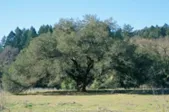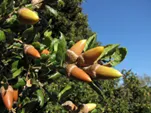By Kim Wilson, UC Master Gardener
 Coast live oak (Quercus agrifolia) | The beautiful panorama of grass covered hills dotted with clusters of California oaks is a characteristic feature of our state. Native oaks provide food and shelter to a wide array of wildlife, protect the soil from erosion and contribute to healthy watersheds. Oak woodlands have decreased due to urban expansion and conversion to profitable agricultural lands to produce food and provide recreation. With approximately 80% of the oak woodlands located on private land, assisting with the restoration of this precious resource is within the grasp of many Californians. |
Acorns which sprout under the shade of established trees are often unable to reach maturity due to competition with the parent tree for sun and nutrients. Successful natural regeneration requires that an acorn be relocated by wildlife and buried at a favorable site, assuming it is not eaten later. The following guidelines cover acorn collection, storage, site preparation, and proper planting, as well as seedling protection and maintenance.
Acorns
- Choose acorns from trees on or near your property. Oaks native to your specific microclimate will have the greatest chance of developing into a healthy long lived tree.
- The healthiest acorns are picked from the tree in early fall when they begin turning from green to brown and the caps are easily removed. Uniformly dark, green acorns are not ready for picking.
- Acorns that have dropped to the ground are usually too dry to be of use but may be used if those with cracks or are light in weight are discarded (see below).
- Remove all the acorn caps. Acorns picked from a tree should be placed in a plastic bag and refrigerated. Refrigeration slows respiration and keeps the acorns from losing excessive moisture. Refrigerating acorns for a month or more has been shown to increase germination success.
- Acorns picked from the ground need to be checked for viability. Place acorns in water and refrigerate. After one day, discard any that float. Save the acorns that sank to the bottom of the container and dry on paper towels for 30 minutes. Place in plastic bag and refrigerate.
- Check acorns during refrigeration for mold. If mold develops, rinse off and place back in refrigerator.
- Some acorns, especially blue oaks, may start to germinate while refrigerated. A small white tip is a sign of healthy root growth. Plant acorns if the root tip begins to turn brown or mushy. Acorns with roots entirely brown or mushy should be discarded. It is best to plant any germinating acorns promptly to prevent spoilage.

Planting
- Plant anytime from early November to early March, after rains have softened the soil. Early planting will allow the acorns to benefit from winter rains.
- Planting site should be sunny, free of competing weeds, and without excessive gopher or ground squirrel activity.
- Plant acorns in clusters of three to four with 30-40 feet between the groupings.
- Clear a 2-3-foot radius of all vegetation around the planting holes, by hand or contact herbicide.
- In the planting hole, loosen the dirt to a depth of 4 inches and plant acorns 1 – ½ inch deep. Plant to depth of 2 inches if squirrels and mice are active in the area. Plant germinated acorns with the tip of the root down, and non-germinated acorns on their sides.
- Place mulch around planting spots to conserve moisture and inhibit weed growth.
Maintenance
- Keep the planting site free of weeds during the first two years.
- Direct planted acorns produce seedlings which require much less water than transplants. So in drought years, once the winter and spring rains have stopped, hand water with 2 gallons of water per seedling; once in July and once in September for the first two years.
- Continued irrigation of the seedlings beyond the first two years is discouraged as it attracts rodents and gophers and does not increase seedling growth and survival rate. Irrigation can inhibit deep rooting needed for proper health and survival of the tree.
- Protect from wildlife by placing protective cages over planting site. Options include cages closed at the top, rigid translucent tubes or screen cylinders. See references below for more information on these devices.
- Do not fertilize any emerging seedlings as it disrupts beneficial soil microorganisms.
A note about acorn production:
You may notice that some years the oak trees have plenty of acorns and other years seemingly none. Environmental factors play a role in acorn production and vary with oak species. Valley and blue oaks have heavier acorn crops in years in which April temperatures are warmer since this corresponds to pollination time. Coast and canyon live oak acorn production correlates with rainfall from one to two years prior to pollination; more rainfall means more acorns.
References
Anderson, Maureen. 2010. Procedure For Planting Fully Sheltered Acorns. PDF. Descanso Ranger District. Microsoft Word - Descanso Oak Reforestation Plan.docx
Bernhardt, Elizabeth and Tedmund Swiecki. 2001. "Restoring Oak Woodlands in California: Theory And Practice." Phytosphere.Com. Restoring oak woodlands in California: theory and practice
McCreary, Douglas. "How To Grow California Oaks." UC ANR. How to Grow California Oaks - PDF - ANR Catalog
"Protection Of Individual Planting Sites." 2016. Phytosphere.Com. Protection of individual planting sites
